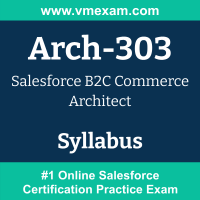 The Salesforce Arch-303 exam preparation guide is designed to provide candidates with necessary information about the B2C Commerce Architect exam. It includes exam summary, sample questions, practice test, objectives and ways to interpret the exam objectives to enable candidates to assess the types of questions-answers that may be asked during the Salesforce Certified B2C Commerce Architect exam.
The Salesforce Arch-303 exam preparation guide is designed to provide candidates with necessary information about the B2C Commerce Architect exam. It includes exam summary, sample questions, practice test, objectives and ways to interpret the exam objectives to enable candidates to assess the types of questions-answers that may be asked during the Salesforce Certified B2C Commerce Architect exam.
It is recommended for all the candidates to refer the Arch-303 objectives and sample questions provided in this preparation guide. The Salesforce B2C Commerce Architect certification is mainly targeted to the candidates who want to build their career in Salesforce Architect domain and demonstrate their expertise. We suggest you to use practice exam listed in this cert guide to get used to with exam environment and identify the knowledge areas where you need more work prior to taking the actual Salesforce B2C Commerce Architect exam.
Salesforce Arch-303 Exam Summary:
|
Exam Name
|
Salesforce B2C Commerce Architect |
| Exam Code | Arch-303 |
| Exam Price |
Registration fee: USD 400 Retake fee: USD 200 |
| Duration | 105 minutes |
| Number of Questions | 65 |
| Passing Score | 65% |
| Recommended Training / Books |
Salesforce B2C Commerce online documentation B2C Commerce Developer with SFRA (CCD102) B2C Commerce Merchant (CCM101) |
| Schedule Exam |
Kryterion Webassessor PEARSON VUE |
| Sample Questions | Salesforce Arch-303 Sample Questions |
| Recommended Practice | Salesforce Certified B2C Commerce Architect Practice Test |
Salesforce B2C Commerce Architect Syllabus:
| Section | Objectives | Weight |
|---|---|---|
| Design/Discovery |
- Given a customer's business requirement, create a technical specification that accurately reflects the business requirement. - Given business and technical requirement details, create standard technical artifacts that are complementary and accurate to the design and project needs. - Given business and technical requirement details, review implementation specifications for solutions, future growth, and gap analysis to stakeholders and provide analysis to defend if necessary. - Given systems integration requirements and technical details, evaluate applicable versions of AppExchange solutions, third-party technical specifications, and API documentation for integrations. - Given the systems that are interacting with the platform, evaluate the integration points, data type and volume, and data migration approach, plus diagram the system architecture. |
29% |
| Build |
- Given a set of technical specifications, evaluate the implementation process to ensure the solution meets the business requirements. - Given an implementation, validate that best practices are followed and guide their usage so that the end solution is secure, performant, and modular. - Given a complex issue or set of issues, guide a development team in the steps toward resolution. - Given an implementation and known key performance indicators (KPIs), support in load testing, evaluate results, and ensure the implementation meets expectations. - Given a collection of cartridges and data, define a process to compile and deploy to Salesforce environments. |
19% |
| Monitoring/Troubleshooting |
- Given an implementation, evaluate the end-to-end needs for custom logging configuration and the ability to leverage Log Center, and investigate other tools required to identify potential and existing issues for governance, trust, and best practices. - Given an implementation performance issue, demonstrate the ability to identify and address existing and potential performance issues, including quota violations, cache utilization, service timeouts, and optimization opportunities. - Given an implementation issue, demonstrate the ability to identify root causes and recommend solutions. - Given an implementation, evaluate and adjust the system proactively to ensure a healthy, scalable system for current and future business operational needs. |
14% |
| Integrations and Customizations |
- Given a business requirement of integrating with a third-party web service, identify which protocol (SOAP/REST) and which approach (real-time vs. batch processing) should be used and then apply all security strategies and best practices that SFCC can support. - Given a set of batch process requirements, leverage the productized Job Framework for batch process integration. - Given a list of third-party AppExchange solutions, identify legacy code that still uses Pipelines and define an integration approach with Controllers. - Given a set of real-time integration requirements, leverage the productized Service Framework for real-time integration. |
22% |
| Launch |
- Given requirements for a site, set up aliases that follow SEO best practices and accurately land customers on the desired domain, locale, and currency. - Given a site launch checklist, identify required rollback steps, plan post-production activities, and ensure all launch tasks are completed. - Given a site launch, monitor launch activities that cover all system health indicators. - Given dependencies between sources of site data, define jobs and data replication schedules. - Given data migration scenarios, plan and support the data migration process. |
16% |
